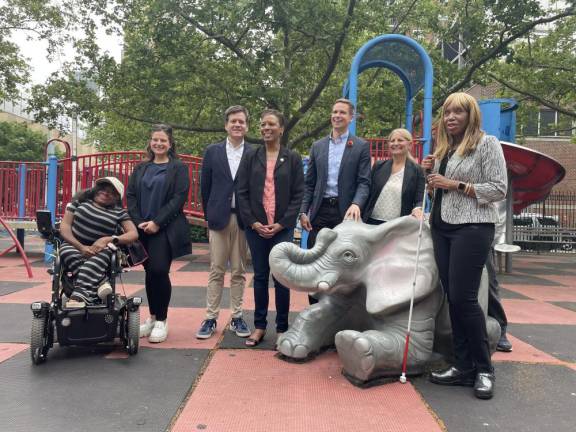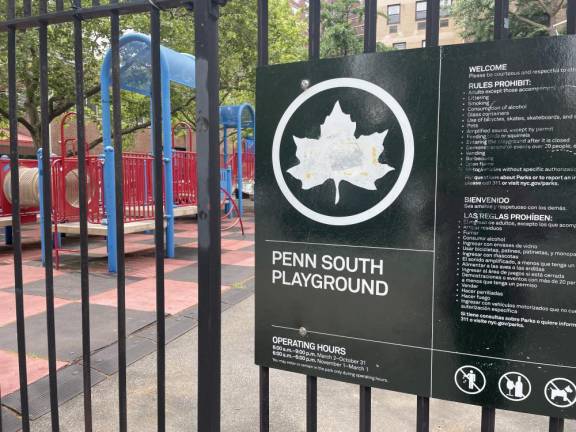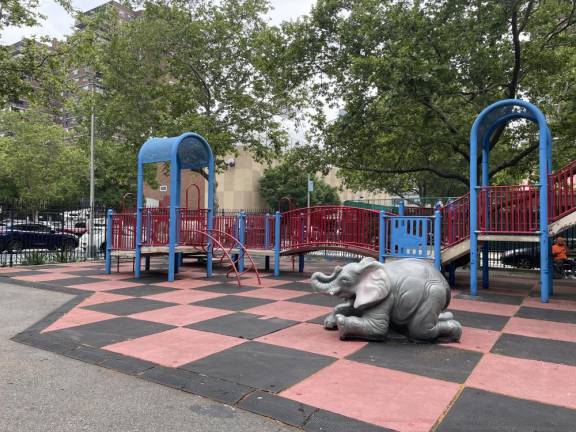A Playground For Everyone
Nearly $4 million of the city’s budget will fund a transformation of Penn South Playground into the district’s first designed for children with disabilities



Penn South Playground, which Council Member Erik Bottcher has said goes mostly unused in its current state, is now due for a major upgrade. With over $3.9 million allocated for renovation in the city’s FY 2023 budget, it will become a playground designed for kids with disabilities.
“I knew there was a reason I like Erik Bottcher,” State Senator Brad Hoylman said during Bottcher’s Tuesday afternoon announcement. “Now we have four million reasons to like Erik Bottcher.”
It will be the first playground of its kind in Council District 3, on West 26th Street between Eighth and Ninth Avenues, Bottcher said. In the city, the Parks Department separates accessible playgrounds into four tiers; a directory compiled by “Let Kids Play!” lists over 50 playgrounds of varying levels of accessibility in Manhattan. For the slated transformation of Penn South Playground, efforts will be made to create a space that accommodates children with all kinds of disabilities, after much community vocalization.
“Every year, we put this park as a priority” on CB4’s annual “statement of district needs,” said Leslie Boghosian Murphy, co-chair of the community board’s Waterfront, Parks and Environment committee.
“Improve The Quality Of Life”
It’s a project that Bottcher has had in mind since his time as former Council Member Corey Johnson’s chief of staff, before being elected as a council member himself. The location is prime for an upgraded, inclusive play space, he explained, since it’s “centrally located in the district and the current playground is highly underutilized.”
“This will improve the quality of life for thousands of New Yorkers with disabilities,” Bottcher told Chelsea News.
At present, the playground isn’t much to look at; a winding slide, weathered paint and a stand-alone elephant statue that Hoylman said his daughter, whom he took to the playground during the pandemic, has dubbed the “saggy, baggy elephant.” At Bottcher’s announcement gathering on Tuesday, the small crowd cheered when asked whether the elephant, like an unofficial mascot, should remain after renovations.
During COVID-19 shutdowns, many in the city came to appreciate outdoor space more deeply, Council Speaker Adrienne Adams said. “What this pandemic has taught us, in our city, are so many, many lessons,” she said, “but one of the most important is the value and importance of our open spaces. Our local neighborhood parks and playgrounds remain havens for us.”
Creating An “Oasis”
The process will start in the coming months, Bottcher said, with a discussion moderated by the Parks Department with experts on accessible design — and open to the public. Last February, Bottcher walked through the site with members of CB4.
The primary focus of renovations will be ensuring that the new playground suits a wide range of needs — not stopping at wheelchair accessibility or “one feature that’s within reach of a wheelchair user,” Bottcher said. “We want equipment designed to be a lot of fun,” he added, “and also help kids with special needs develop their motor skills, their physical strength, social skills and more.”
“All types of disabilities need to play,” Sharon McLennon-Wier, the executive director of the Center for Independence of the Disabled, New York, said. “Accessible” playgrounds may include alternatives to traditional swing sets, slides or merry-go-rounds and ramps for those using wheelchairs, while “inclusive” playgrounds — a step up — may boast “calm areas,” activities that engage various senses, pathways that are easy to navigate and play features with varying levels of challenge, according to Playworld, a manufacturer of playground equipment. At Penn South Playground, the adjoining basketball courts will also be resurfaced.
Adaptive Design Association, a local nonprofit that creates custom equipment for people with disabilities, will weigh in on the playground’s design. Identifying children who would benefit from the group’s services in the district has been difficult, explained Jennifer Hercman, the organization’s executive director. A park — serving as a meeting place — could foster a sense of community and make connecting people with services easier. “It’s going to be an oasis,” Hercman said.
“If you build it,” Boghosian Murphy said, “they will come.”
“This will improve the quality of life for thousands of New Yorkers with disabilities.” Council Member Erik Bottcher